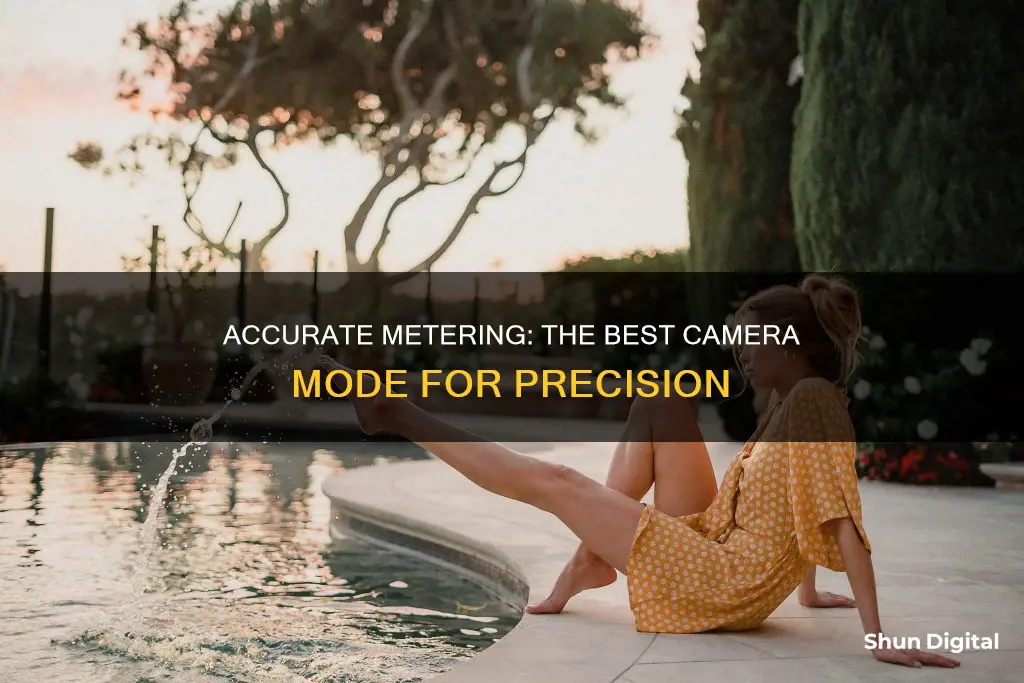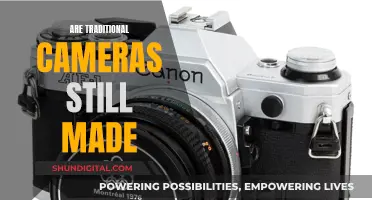
Metering modes are one of the most important settings on your camera. They determine how your camera meters light and, in turn, how your photos look. The metering mode in photography refers to the method a camera uses to measure the brightness of a scene before capturing an image. It helps determine the exposure settings by analysing the light in the frame. The most common metering modes in digital cameras today are: Evaluative/Matrix/Multi Metering, Centre-Weighted Metering, Highlight-Weighted Metering and Spot Metering.
What You'll Learn

Evaluative/Matrix/Multi Metering
Evaluative Metering (Canon), also known as Matrix Metering (Nikon) or Multi Metering (Sony/Fujifilm), is the default metering mode on most digital cameras. It is considered the most complex and modern way of metering a scene. It works by dividing the entire frame into multiple "zones" or "segments", which are then all analysed individually for light and dark tones.
The camera collects data across the entire frame and prioritises the focus point. It takes into account factors like the overall brightness, contrast, and the subject's distance. It is a good starting point when the entire scene's exposure is important, such as in landscapes. It is also useful when the dynamic range of the photo is very small, with no strong shadows or highlights.
More advanced Evaluative/Matrix/Multi Metering systems may use machine learning algorithms to figure out the scene in front of the camera and adjust the exposure accordingly. One of the key factors that affects this metering mode is where the camera focus point is set. After reading information from all individual zones, the metering system marks the focus point as more important than all other zones.
This metering mode is generally a good choice for most photography needs, including landscape and portrait photography. It is also a good choice when you want to capture a scene with no strong shadows or highlights, as it helps the camera balance the exposure with the help of light metering.
Troubleshooting Guide: Camera Won't Charge?
You may want to see also

Centre-weighted Metering
Center-weighted metering is a camera metering mode that evaluates the light in the middle of the frame and its surroundings, ignoring the corners. It is useful when you want the camera to prioritize the middle of the frame, which works great for close-up portraits and relatively large subjects that are in the middle of the frame. For example, if you were taking a headshot of a person with the sun behind them, this mode would expose the person's face correctly, although everything else would probably be heavily overexposed. Center-weighted metering can be more useful for backlit subjects where some overexposure near the strong backlight is expected.
Center-weighted metering is halfway between Evaluative (Multi or Matrix) and Partial Metering. It measures the exposure of a large metering spot in the camera's viewfinder. Most people take photographs in which the subject is in the metering center of the image. Camera manufacturers have included an effective center-weighted metering system in cameras, so photographers can reach an accurate exposure value.
The outcome of center-weighted metering can be hard to predict in digital photography. It is suggested to only use it when the corners of the frame are not very important. Look in the viewfinder and consider how much detail you need to keep in the corners.
Center-weighted metering is best suited for any image where the subject is in the centre of the frame, or even where the subject fills the majority of the scene. A typical example of this would be portrait photography or macro photography. The key thing to keep in mind when using this mode is that the rest of the scene may be under or overexposed.
Creating Custom Camera Raw Presets: A Step-by-Step Guide
You may want to see also

Spot Metering
- Wildlife photography, especially when a bird is in flight against a bright sky or clouds
- Portrait photography of a subject with darker skin, photographed against sky or snow
- Shooting the moon
- Theatre photography, where brightly lit actors are in a darkened auditorium
To use Spot Metering, simply point the centre dot in your viewfinder at your subject and dial your camera settings until the dot registers as "0" or neutral. Then, re-compose your shot if you don't want your subject in the middle of the frame.
You can also experiment with Spot Metering at +1 or -1 to see how that looks. This is a common technique when photographing portrait subjects with different skin tones.
Charging Sanyo VPC Camera: A Step-by-Step Guide
You may want to see also

Partial Metering
The best time to use Partial Metering is when the background is much brighter than the subject. For example, if you are taking a photo of a person standing next to a window with bright sunlight shining through, Partial Metering will help to prevent the person from appearing as a dark silhouette in the photo.
Nature photographers can also benefit from using Partial Metering when photographing wildlife. It helps to create a much nicer exposure and a more detailed subject, whether your subject is people or wildlife.
Sharpening RAW Files: In-Camera vs Post-Processing
You may want to see also

Highlight-Weighted Metering
To activate Highlight-Weighted Metering on a Nikon camera, press the metering button on the far-left dial on the camera body and, while holding it down, rotate the main command dial until the highlight-weighted metering icon is displayed.
While Highlight-Weighted Metering can be a useful tool in certain situations, it is not the best solution for everyday shooting. It is designed for scenes with extreme contrast between the lightest and darkest portions of the image. In most cases, Matrix Metering will give you a properly exposed shot that can be tweaked if needed.
How Masking in Adobe Camera Raw Transforms Photos
You may want to see also
Frequently asked questions
Evaluative metering is the most popular metering mode and is considered the most accurate. It is the default metering mode on most cameras and works well in most lighting situations. It is also known as Matrix Metering on Nikon cameras and Multi-pattern on Sony cameras.
Wildlife photography can benefit from using all the camera metering modes depending on the situation. For general scenes, matrix metering is the most recommended. If your subject is in the middle of the frame, centre-weighted metering is a good option. If your subject occupies a small area of the frame, spot metering is a good choice.
The best metering mode for portraits depends on the number of subjects, their position, and the available light. You can use any of the three main metering modes: evaluative, centre-weighted, and spot metering.
Scenes that are overwhelmingly white or black can confuse the camera's metering mode as it tries to adjust the values to 18% grey. In these cases, you can use exposure compensation to correct the exposure.







